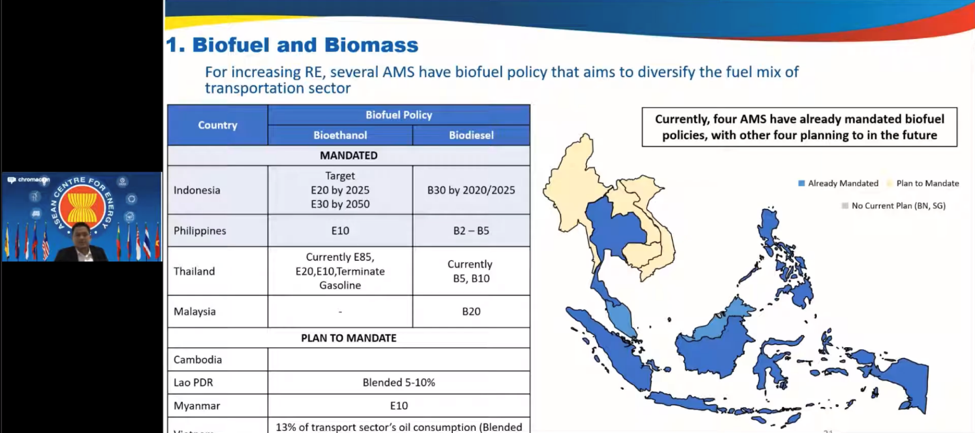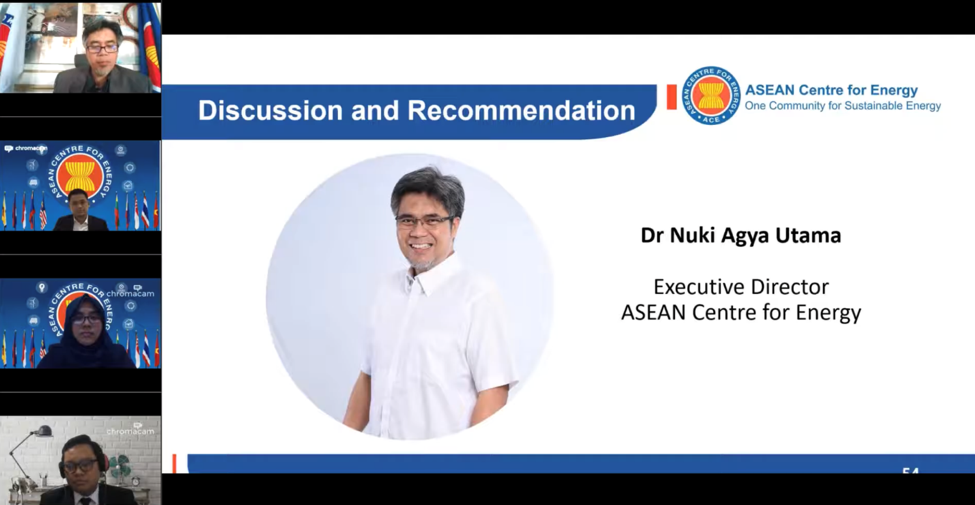Menu
Online, 8 April 2019In accordance with ASEAN Plan of Action and Energy Cooperation (APAEC) Phase II: 2021-2025, ASEAN Centre for Energy (ACE) held a virtual workshop to embrace the importance, achievements, and goals of Renewable Energy (RE) within the ASEAN Member States (AMS) to acquire regional energy target and national climate commitment. The workshop was moderated by Dr. Nuki Agya Utama, Executive Director of ACE. Representatives from each pillar of ACE namely Energy Policy Planning and Modelling (MPP), Sustainable Energy, Renewable Energy and Energy Efficiency (REE), and Power Fossil Fuel, Alternative Energy, and Storage (PFS) Department were invited as speakers.
Dr. Andy Tirta from MPP department pointed out on how to achieve APAEC Phase II target based on findings of the 6thASEAN Energy Outlook (AEO6). APAEC Phase II now focused on enhancing energy connectivity and market integration in ASEAN to achieve energy security, accessibility, affordability, and sustainability for all, with regional targets in 2025 are achieving 23% RE in Total Primary Energy Supply (TPES) and 32% energy intensity reduction compared with 2005 level.
ASEAN TPES is currently still dominated by oil. However, ASEAN’s oil reserves to production (R/P) ratio have decreased from 2008-2017 to 13.6. It means that at the 2017 level of production, ASEAN oil reserves will last less than 14 years before being depleted. This fact encourages AMS to increase dependency towards RE to fulfil their energy needs. ASEAN power capacity in 2018 has increment of RE share, with achievement up until 26.8%. ASEAN TPES 2025 baseline consists of 14% RE share, while the ASEAN country target scenario (ATS) and APAEC target scenario (APS) respectively are 18% and 23%.
ASEAN Total Final Energy Consumption (TFEC) in 2040 is projected to increase by around 2.45 times from the 2017 level, with industry and transportation sectors leading the growth. Fossil fuels contribute to 63% of TFEC in 2017, with oil having the largest share (47%). Disaggregated by sector, industry is projected to hold the most share in all scenario, followed in order by transportation, residential, commercial, and agriculture. The ASEAN is projected to be the natural gas importer before 2025. In order to reach the APAEC targets, ASEAN must fill the gaps between the current national target and the aspirational regional target by developing appropriate policies and effective strategies.

Some sources that have been developed to move from ATS to APS and decrease fossil fuel dependency, are RE from biofuel and biomass. Several AMS have biofuel policy that aims to diversify the fuel mix of transportation sector. Currently, four AMS (Indonesia, Philippines, Thailand, Malaysia) have already mandated biofuel policies, with other four (Cambodia, Lao PDR, Myanmar, Vietnam) are planning to in the future. Indonesia targeted bioethanol E20 by 2025 and E30 by 2050 and biodiesel B30 by 2020/2025. APS planned to inject 48% RE to ASEAN power sector by 2025.
Based on the evidence, AEO6 concluded some recommendations. The Energy Efficiency (EE) target fulfilment will reduce the gaps between planned RE power plant with the regional target ambition. Investment in grid improvements and technologies and strengthening emission standards are also crucially needed.
Ms. Monika Merdekawati from REE department discussed the RE status, potential, and opportunities in ASEAN and initiatives under APAEC Phase II. Covid-19 pandemic has given significant multiplier effects on electricity sector. These effects include decrease of power usage, electricity use and demand; net profit loss of electricity sales; increase of vulnerable groups; further financial loss to provide electricity tariff relief; redesign of Power Development Plan (PDP); and delay of power plants. Although Covid-19 pandemic disrupted financial health of state-owned utilities and supply chain of RE, it is known that the RE is more resilient than oil & gas sector. Resiliency of renewables sector gets more prevalent throughout the year.
Based on ACE survey result, fossil fuel (coal, oil, and gas) is the most impacted energy sector from Covid-19 pandemic by 68%, while RE only 16%. Oil & gas companies are rethinking their investment to be more into clean energy technologies. British Petroleum (BP), Equinor, Shell, and Total targeted net zero by 2050. PERTAMINA, Petronas, and AC Energy are also diversifying towards RE. The global net zero initiatives are supported by ASEAN cooperation, UN Climate Change Conference UK 2021, and US President recent announcement on USD 2 trillion climate plan. Supporting RE program area of APAEC, there are 6 outcome-based strategies and 16 action plans. The strategies are to advance RE policy and decarbonisation pathway, conduct high level policy dialogue on RE, enhance RE R&D, promote RE financing schemes and mechanism, support biofuel and bioenergy development, enhance RE information and training centre.
Dr. Akbar Swandaru from PFS department discussed findings and recommendations of RE development from ASEAN Interconnection Masterplan Study III (AIMS III). AIMS III provides an update plan of regional transmission network that links ASEAN power system with the maximized utilization of regional RE resources. Phase I of AIMS III focused on capacity expansion planning including RE Resource Assessment which have been completed, followed by on-going Phase II on grid performance analysis and Phase III on multilateral market analysis in 2021.
ASEAN has more RE potential to be utilized beyond PDP. ASEAN has 42 solar sites with potential gross capacity 8,119GW, out of which Indonesia has 5 solar sites; and 20 wind sites with potential gross capacity 342GW. AIMS III produced materials that can be used for national planning, which are complete solar and wind maps of ASEAN and complete monthly generation and diurnal profiles. RE resource assessment identified results for ASEAN Solar Map. The Solar Map gives visual information for solar power distribution in AMS.
In 2025, under the Base Case, all RE is around 31% of the total installed capacity. But under APAEC RE Target, it can go up to 44% (adding 10%). Under the Base Case, AMS are planning to have 19.2GW solar and 6.5GW installed capacity by 2025. Thus, to add 10% of RE shares, at least 63GW solar and 5.8GW wind are required. Through AIMS III study, the distribution of solar potential is more fairly distributed than the Base Case. Each AMS do have fairly possible opportunity to contribute to the acceleration of clean energy transition to achieve the new 2025 ASEAN RE target with total installed power capacity of 35%, even beyond.
The AIMS III study suggested that RE has a key role to play in the decarbonisation of the energy sector and the resulting mitigation of climate change. Nationally Determined Contributions (NDCs) have not kept up with recent rapid growth in renewables. However, our APAEC target, especially the ASEAN RE target, could help assist the process by enabling the AMS to reach higher avoider Green House Gas (GHG) emissions each year as a result of RE deployment.

Dr. Nuki further led the workshop to discussion and recommendation. The discussion focused on RE challenges and opportunities in AMS. He then wrapped up the session by mentioning the importance to resolve challenges in achieving sustainable, affordable, and secure energy supply. Also, the ASEAN power grid or the interconnection is a very important aspect in order to increase the RE share especially Variable Renewable Energy (VRE) in the region. As the speakers noted that it is possible to achieve 23% RE share of TPES in 2025 and 37% RE share of installed power capacity. There are still financial issues in the region, while the development of policies and studies are crucial. As a think tank organization, ACE strives to be a reference or source of information for policy making to drive more resilient and secure energy supply in the region.
(SNF)
By Shahnaz Nur Firdausi
